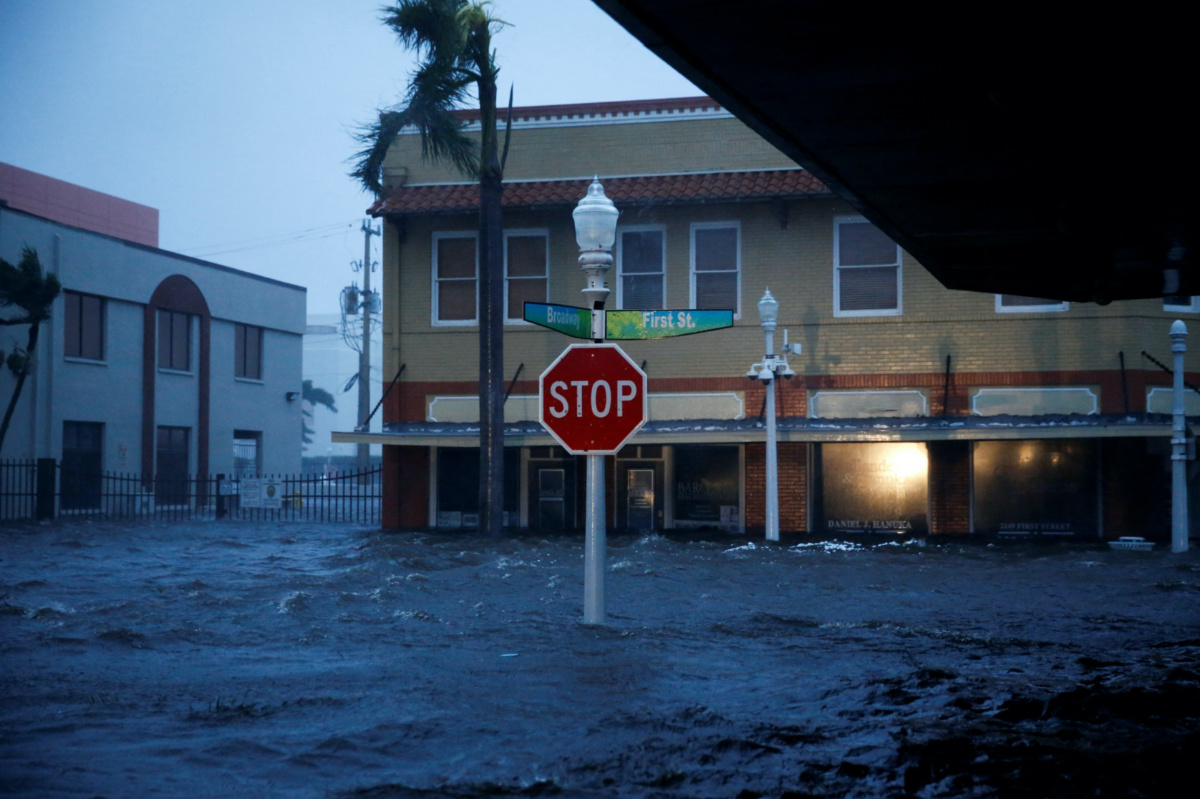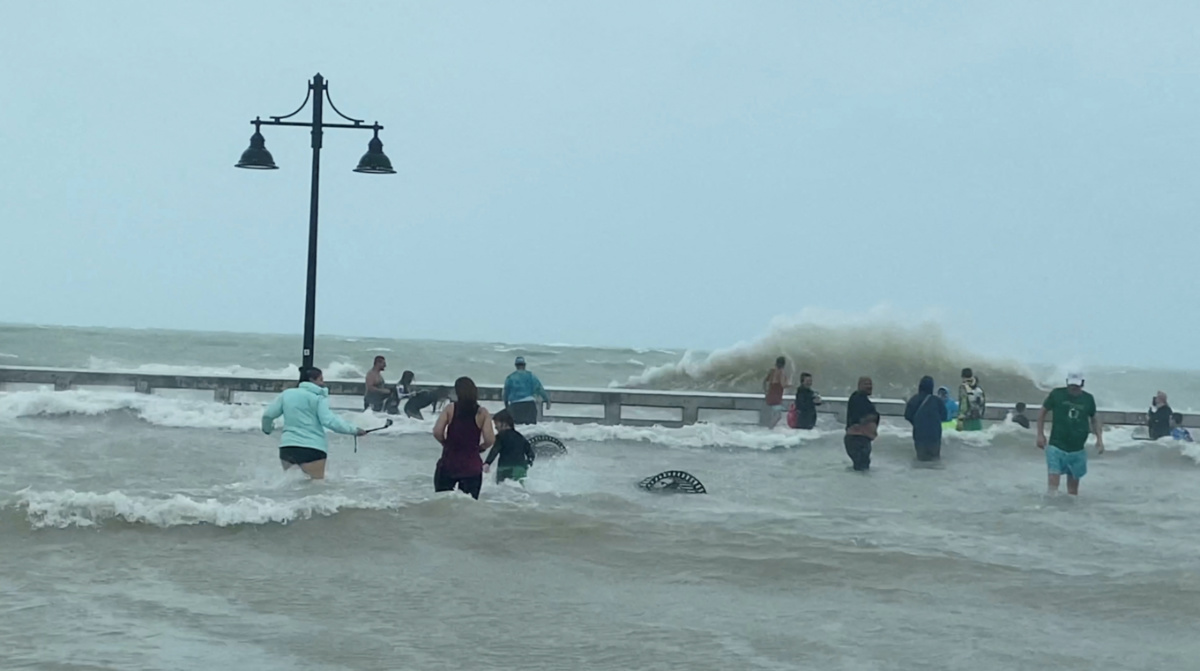Updated: 12.25pm (AEST)
Venice, Florida, US
Reuters
Hurricane Ian plowed into Florida’s Gulf Coast with catastrophic force on Wednesday, unleashing howling winds, torrential rains and a treacherous surge of ocean surf that made it one of the most powerful US storms in recent years.
Crashing ashore as a Category 4 hurricane with sustained winds of up to 241 kph, Ian quickly transformed an idyllic stretch of sandy beaches and coastal towns into a disaster zone inundated by seawater.

A flooded street is seen in downtown as Hurricane Ian makes landfall in southwestern Florida, in Fort Myers, Florida, US, on 28th September. PICTURE: Reuters/Marco Bello
Early video images of the storm’s fury on local TV and social media showed floodwaters sweeping away cars, nearly reaching rooftops in some communities and the ruins of homes as palm trees were bent almost in half.
CUBAN MIGRANT BOAT SINKS OFF FLORIDA DUE TO HURRICANE IAN; 20 MISSING
US Border Patrol said on Wednesday that 20 people were missing off the coast of Florida after a Cuban migrant boat sank due to Hurricane Ian.
The Border Patrol agents responded to a migrant landing in Stock Island, Florida, officials said on Twitter. The US Coast Guard had initiated a search operation for 23 missing people, with the agency later saying it had rescued three of them. They were taken to a local hospital for symptoms of exhaustion and dehydration.
Four additional Cuban migrants swam to shore after their vessel sank due to inclement weather, Chief Patrol Agent Walter Slosar said. Local media said those four also were hospitalised.
On Tuesday, the storm thrashed Cuba, knocking out the electrical grid for 11 million people and ravaging the western end of the island with violent winds and flooding. By early Wednesday, the state electricity provider said it had begun to restore power across the eastern end of the island.
Ian’s thrashing of Cuba left at least two people dead, both deaths occurring in the hard-hit western province of Pinar del Rio. A woman died after a wall collapsed on her and a man died after his roof fell on him, state media said.
The hurricane hit Cuba at a time of dire economic crisis. Blackouts and long-running shortages of food, medicine and fuel were likely to complicate efforts to recover from Ian.
On Tuesday, seven migrants from Cuba were taken into custody after they made it to shore in Pompano Beach, Florida, US authorities said.
“Do not risk your life by attempting this journey at sea. Storm surge along with King tide can create treacherous sea conditions even after a storm passes,” officials said on Twitter on Tuesday when announcing those detentions. King tides are exceptionally high and can cause tidal flooding.
– KANISHKA SINGH/Reuters
Up to 76 centimetres of rain is forecast to fall on parts of central Florida as the storm moves inland, threatening to cause extensive flash floods. Nearly two million homes and businesses statewide were without power as of an hour before sunset, utilities reported.
“This storm is doing a number on the state of Florida,” said Governor Ron DeSantis, who asked US President Joe Biden to approve a major federal disaster declaration providing a wide range of US emergency aid to the entire state.
There were no immediate official reports of storm-related casualties.
An unknown number of people were stranded in “high-risk” evacuation zones and in need of help after defying orders to seek higher ground, but rescue crews were unable to immediately reach them, the governor said.
Having swept past Cuba on Tuesday, leaving it without power for hours, Ian made landfall in Florida at 3:05pm EDT on Wednesday near Cayo Costa, a barrier island just west of Fort Myers, the US National Hurricane Center reported.
The storm’s peak wind speeds put it just shy of a Category 5 designation on the Saffir-Simpson scale, the maximum classification.
Ian then churned ashore on Florida’s mainland, south of the harborside town of Punta Gorda, with slightly diminished winds topping out at 145 mph.
DeSantis said Ian had generated life-threatening storm surges – waves of wind-driven seawater rushing in along the coast – of up to 3.7 metres in some places. Forecasters also warned of intense thunderstorms and possible tornadoes.
“This is a storm that we will talk about for many years to come, an historic event,” said Ken Graham, director of the National Weather Service.
The sprawling, slow-moving storm pushed farther inland as darkness fell, and within six hours of landfall was downgraded to Category 2, with top sustained winds of 170 kmh, the NHC reported.
Further weakening was forecast over the next day or so as Ian crosses the Florida peninsula on a northeasterly track, expected to reach the Atlantic Coast on Thursday afternoon.
Scenes of devastation
The region around the landfall is home to miles of sandy beaches, scores of resort hotels and numerous mobile home parks, a favourite with retirees and vacationers alike.
An hour after landfall, video posted on social media and TV news outlets showed water fueled by storm surges rushing through several communities.
The town of Fort Myers Beach was nearly submerged by floodwaters. A view of Sanibel Island posted on Twitter showed the ocean sweeping over a seawall into a resort hotel’s swimming pool. Other video from the island showed roads inundated by the storm surge, rising to the tops of street signs.
In terms of its sustained wind speeds, which peaked at 249 kph before landfall, Ian ranks as one of the most ferocious hurricanes to strike the US mainland in recent years. By comparison, Hurricane Michael came ashore in Florida’s panhandle in 2018 with steady winds of 249 kph, while Ida last year packed sustained winds of 241 kph when it landed in Louisiana.

People gather at Key West pier as Hurricane Ian approaches, in Key West, Florida, on 27th September. PICTURE: Gwen Filosa/via Reuters
We rely on our readers to fund Sight's work - become a financial supporter today!
For more information, head to our Subscriber's page.
To stay or go
Even as Ian lashed the coast in the final hours before it swept ashore, authorities warned residents it was too late for anyone who had yet to evacuate to safely do so.
Earlier this week, more than 2.5 million residents had been told to evacuate. Doug Coe of Venice was one of those who chose to ignore warnings and stay put.
“I’m staying vigilant, but trying not to worry,” he said.
Most residents abandoned the area’s mobile home parks, taking refuge in local schools and other facilities converted to emergency shelters. The area’s numerous assisted-living facilities were mostly evacuated, too.
Climate change is making hurricanes wetter, windier and more intense. There is also evidence that it is causing storms to travel more slowly, meaning they can dump more rain in one place, scientists say.
– Additional reporting by JARRETT RENSHAW, LEAH DOUGLAS, KANISHKA SINGH and TYLER CLIFFORD in Washington; RICH MCKAY in Atlanta, and DAN WHITCOMB in Los Angeles.






